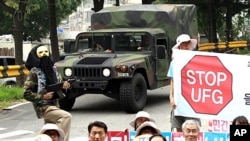The South Korean and United States navies began joint military exercises Tuesday in the Yellow Sea. Those waters are a flashpoint of tension between North and South Korea and have been the site of several deadly incidents during the past decade. Analysts say the volatility stems in part from a maritime border that has been in dispute for almost 60 years.
Tens of thousands of American and South Korean military personnel are taking part in the annual joint naval drills, called Ulchi Freedom Guardian. The exercises will last for 10 days in the Yellow Sea off the west coast of the Korean peninsula.
The Defense Ministry here in Seoul says these maneuvers are aimed at simulating the destroying of North Korea’s weapons of mass destruction. U.S. commanders say the exercise is routine and defense-oriented.
Speaking through its official media, Pyongyang has urged Seoul and Washington to call off the drills, saying they increase the likelihood of nuclear war.
A North Korean newscaster calls for the United States and South Korea to cancel the military exercises targeting the North if they want to normalize relations.
The Yellow Sea is a contentious region between the two Koreas because of the maritime boundary known as the Northern Limit Line, which was created at the end of the Korean War in 1953.
Some analysts say that calling this demarcation line an actual border is misleading.
“First of all I wouldn’t say it’s a border according to international law," said Daniel Pinkston, Northeast Asia deputy project director at the International Crisis Group in Seoul. "The two opposing sides tried to address the maritime issues during the negotiations for the armistice agreement, but the Northern side didn’t really want discuss it, they didn’t have a navy or it wasn’t a concerned about it. So the armistice was signed without any references or provisions for maritime boundaries.”
Pinkston says, because of that ambiguity, the Washington-backed United Nations Command drew up an arbitrary line that has acted as the de-facto boundary ever since.
This area in the Yellow Sea has seen several naval battles in just the past decade, which have killed dozens of sailors on both sides.
But, 2010 saw the greatest loss of life, when 46 South Korean sailors died as their naval ship, the Cheonan, was allegedly torpedoed by the North - a claim Pyongyang denies. And, in November of last year, Yeonpyeong Island was shelled by North Korean forces, killing four South Koreans.
Just last week in the same region, Seoul says it responded to three rounds of artillery fire from the North with an equal number of shots. Pyongyang says the South mistook the sound of construction blasts for weapons fire.
Pinkston says there is concern that South Korea forces might overact to perceived provocations.
“There’s a lot of political pressure to respond to any kinetic provocations like we saw last year," said Pinkston. "The defense minister has told units to fire first and ask questions later, essentially”
Pinkston adds there are those in South Korea who would like revenge against North Korea for last year’s attacks. And, that that could increase the likelihood of another battle in the Yellow Sea.












